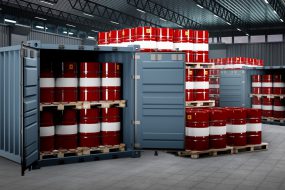In an industry where precision and timing are everything, managing inventory in oil and gas isn’t just a matter of keeping shelves stocked — it’s a fine balance between cost, efficiency, and resilience.
From drilling equipment and replacement parts to safety gear and consumables, oil and gas companies rely on streamlined inventory systems to keep operations running smoothly. When that balance tips too far — whether through overstocking or unexpected shortages — the consequences can ripple across the entire supply chain.
So, how do the most efficient oil and gas logistics companies do it? The answer lies in blending technology, strategy, and collaboration to create smarter warehousing and logistics operations that are ready for anything.
Related Reading: Managing hazardous cargo in oil and gas supply chains
Why inventory optimisation matters more than ever
Optimising your inventory isn’t just about cutting costs. It’s about building a system that’s agile enough to respond to market volatility, resilient enough to handle supply chain disruptions, and efficient enough to reduce waste.
Here’s what effective optimisation delivers:
- Reduced costs – Less excess stock means lower storage and holding costs.
- Operational efficiency – Materials are available when and where they’re needed, reducing downtime.
- Improved decision-making – With better data, teams can forecast demand and plan more accurately.
- Smarter resource use – Every asset and piece of equipment is accounted for, tracked, and utilised effectively.
In a sector where margins can shift overnight, optimised inventory is a competitive advantage.
Related Reading: Sustainable logistics: new trend in oil and gas supply chain
Building a foundation: warehousing, software, and logistics
The foundation of strong inventory management begins with three key pillars — warehousing and storage, digital tools, and dependable logistics partners.
1. Get your warehousing and storage right
Not all storage is created equal. Oil and gas materials often require specific conditions — from climate control to secure handling and compliance with safety regulations. Modern warehouses designed for oil and gas logistics provide the infrastructure to protect valuable inventory and maintain accessibility.
2. Invest in inventory management software
Advanced inventory management software has become a non-negotiable tool for the sector. The best systems track stock levels in real time, automate reordering, and generate analytics that highlight inefficiencies before they become problems.
Automation is also reducing the manual burden on teams, cutting down on human error and freeing staff to focus on higher-value tasks. In short: smarter systems make for smoother operations.
3. Partner with the right logistics provider
Reliable delivery is critical. Partnering with experienced oil and gas logistics companies ensures your equipment and materials move efficiently across vast distances — whether by air, sea, or land. A strong logistics network helps maintain optimal inventory levels, minimising the risk of delays that could stall entire projects.
Strategies to take inventory performance to the next level
Efficient warehousing and logistics depend on thoughtful strategy as much as smart technology. Here are some proven tactics to fine-tune your operations:
Audit regularly
Frequent audits keep your inventory data accurate, helping prevent discrepancies or costly stockouts. They also provide valuable insights into patterns of use and demand.
Forecast demand using data
Accurate forecasting is the backbone of effective inventory management. Using data from inventory management software alongside market analysis helps predict future demand and align inventory accordingly.
Build stronger supplier relationships
Open communication and long-term partnerships with suppliers lead to better pricing, shorter lead times, and greater flexibility when markets shift.
Automate reordering
An automated reorder system removes guesswork. When stock levels dip below a certain threshold, the system triggers replenishment automatically — maintaining balance without overcommitting resources.
Related Reading: Logistical challenges in oil and gas – and how to solve them


Navigating industry challenges
The oil and gas sector operates under unique pressures. Market volatility, complex supply chains, and regulatory demands all add layers of challenge to inventory management.
- Market volatility: Prices and demand can fluctuate rapidly. The solution? Build flexibility into your inventory strategy so you can scale up or down as needed.
- Complex supply chains: With multiple suppliers, routes, and distribution channels, visibility is essential. Integrated inventory management software offers transparency across every link in the chain.
- Regulatory compliance: Safety and environmental regulations shape how materials are stored, transported, and documented. Partnering with compliant warehousing and logistics providers can help avoid penalties and maintain standards.
The future of oil and gas logistics
As the industry continues to evolve, oil and gas logistics will increasingly rely on technology to drive accuracy and sustainability. Automation, artificial intelligence, and predictive analytics are already reshaping how companies manage their inventory, offering real-time insights and helping to forecast potential disruptions before they happen.
At the same time, sustainability is becoming a critical factor. From reducing waste in warehousing and storage to optimising delivery routes and improving energy efficiency, greener logistics practices are becoming part of everyday operations.
Related Reading: Smarter logistics for remote energy sites
Key Takeaway
Optimising your oil and gas inventory isn’t about doing more — it’s about doing better. By combining advanced inventory management software, efficient warehousing and storage, and strong partnerships with oil and gas logistics companies, businesses can reduce costs, increase efficiency, and stay resilient in a volatile market.
In a sector where every decision counts, smarter inventory management isn’t just a competitive edge — it’s essential for long-term success. Ready to get started? Reach out today.




